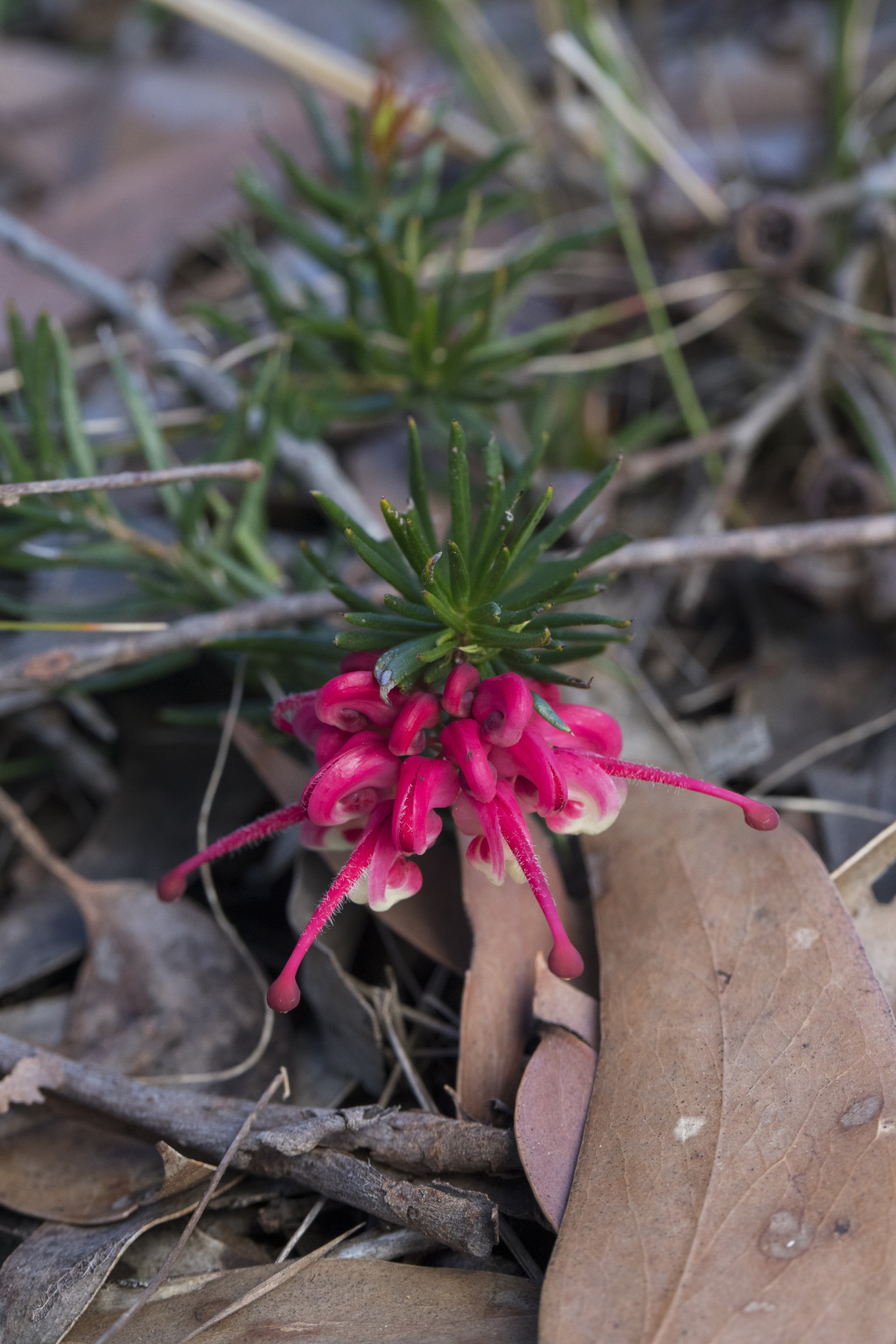Grevillea rosmarinifolia
A.Cunn. Rosemary GrevilleaCompact to open shrub 0.3–2 m high. Leaves entire, linear to narrowly oblong-elliptic, 0.8–3.8 cm long, 0.5–3 mm wide; lower surface loosely tomentose, subsericeous, or rarely glabrous, usually largely obscured by the revolute margin. Conflorescences terminal, usually decurved, usually simple; ultimate rachises glabrous; perianth strongly pouched at base on ventral side, pink to red, often paler dorsally and apically, rarely greenish, outer surface glabrous, inner surface bearded; pistil 15–22.5 mm long, stipe ventrally gibbous, 0.7–1.4 mm long, with hairs ventrally and laterally, ovary usually glabrous, occasionally villous in lower half, style pink to red, glabrous or with scattered erect hairs, pollen presenter lateral. Fruits glabrous, with faint longitudinal ridges. Flowers mainly spring.
LoM, MuM, Wim, GleP, VVP, VRiv, GipP, OtP, Gold, CVU, GGr, DunT, NIS, EGU, HSF, HNF, OtR, Strz, VAlp. In western Victoria on sandy soils in mallee or shrub associations, or occasionally on basaltic soils.
Naturalized in several areas from cultivated plants (e.g. Mitcham, Alexandra, Hurstbridge), and sometimes interbreeding with indigenous local forms.
Grevillea rosmarinifolia grades morphologically and ecologically from the New South Wales Southern Tablelands (where it has a bushy to erect habit, relatively broad leaves, open foliage, and a mesic habitat) through northern and central Victoria (sporadic occurrences, variable shrubby to near-prostrate habit, and variable leaves), to western Victoria and inland New South Wales (where it is a more gregarious plant characterized by a consistently upright and dense-foliaged habit with leaves to 1 mm wide). This last variant is occasionally recognized as G. glabella R. Br. The ends of the cline are distinct but the transition zone, involving most Victorian populations, grades in both directions. Recent treatments (McGillivray & Makinson 1993; Makinson in Walsh & Entwisle 1996; Olde & Marriott 1995, have synonymised G. glabella because of the difficulty of delimitation and the ambiguous placement of many populations from central and western Victoria. Makinson (2000) resurrected 'G. glabella', treating it as a subspecies of G. rosmarinifolia. The taxonomy of G. rosmarinifolia remains unresolved. Olde & Marriott (1995) note that there are several different forms in Victoria. In eastern Victoria, the 'Crooked River form' is a dense shrub to 2 m tall, with green linear leaves and dull pink and cream flowers. This form is one of the most commonly cultivated grevilleas. Near Geelong there was the 'Lara form', which is now extinct in the wild. This form is a low rhizomatous shrub to 40 cm tall, with bluish grey leaves. Populations from Craigieburn and Anakie are similar to the 'Lara form', but are more robust.
Apparent morphological intergrades with G. lanigera occur in eastern and central Victoria (see Willis 1973, p. 46, where a 'widespread riparian population' of such intermediates is referred to G. lanigera); some such populations may deserve formal recognition, or inclusion in a more broadly circumscribed G. rosmarinifolia. See note under G. lanigera.
Two subspecies are recognised, both present in Victoria.
Makinson, R.O. (1996). Grevillea. In: Walsh, N.G.; Entwisle, T.J., Flora of Victoria Vol. 3, Dicotyledons Winteraceae to Myrtaceae, pp. 845–870. Inkata Press, Melbourne.
 Spinning
SpinningMakinson, R.O. (2000). Grevillea. In: Australian Biological Resources Study, Flora of Australia vol. 17A, Proteaceae 2, ~Grevillea~, pp. 1–524. CSIRO Publishing.
Olde, P.; Marriott, N. (1995). The Grevillea Book. Kangaroo Press, Kenhurst, NSW, Australia.




